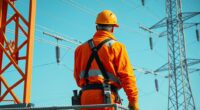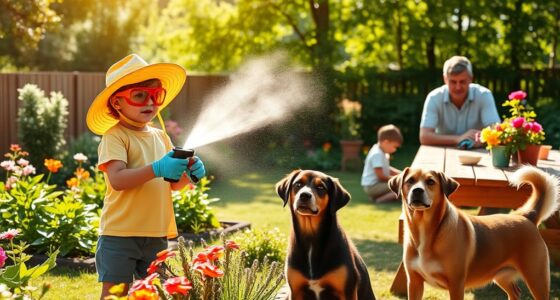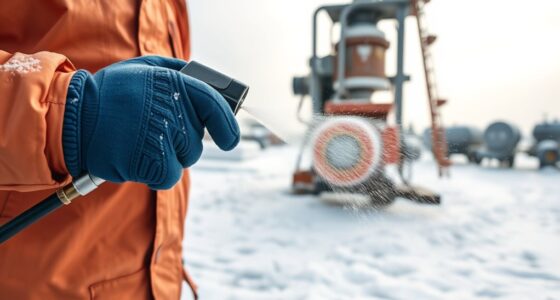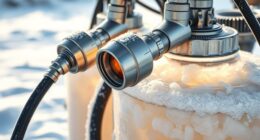To stay safe as a sprayer operator, you need proper PPE like gloves, masks, goggles, and protective suits that meet safety standards. It’s essential to understand how to wear and remove them correctly and to inspect and replace worn-out gear regularly. Proper maintenance and training help you avoid chemical contact and keep equipment functioning. Staying informed on safety regulations ensures you’re protected. Keep going to learn more about maintaining your PPE and working safely.
Key Takeaways
- Select PPE that meets safety standards and fits properly to ensure maximum protection during spraying activities.
- Regularly inspect, clean, and maintain PPE to prevent damage and ensure effectiveness.
- Properly train on correct donning, doffing, and equipment handling to minimize contamination risks.
- Replace worn or damaged PPE immediately to maintain safety and prevent chemical exposure.
- Stay updated on safety regulations and continuously review PPE protocols for optimal protection.

Sprayer operators face exposure to hazardous chemicals, making the use of proper personal protective equipment (PPE) crucial for safety. Wearing the right gear helps prevent chemical contact with your skin, eyes, and respiratory system. But PPE isn’t just about having the gear—it’s also about maintaining it properly and knowing how to use it correctly. Regular equipment maintenance ensures your PPE remains effective. For example, inspect your gloves, masks, and suits before every use to look for tears, cracks, or wear. Damaged PPE can give a false sense of security and increase your risk of exposure. Cleaning and storing your equipment properly after each use prolongs its lifespan and keeps it ready for the next job. When replacing PPE, always opt for items that meet safety standards and fit well; ill-fitting gear can be uncomfortable and less protective. Proper training in PPE use is essential to ensure that operators understand how to correctly don, doff, and maintain their gear. Safety training plays a critical role in helping you understand how to use PPE effectively. Proper training teaches you how to don and doff equipment without contaminating yourself, which is essential when working with toxic chemicals. It also covers how to recognize when PPE needs replacing or repairing. Your employer should provide extensive safety training that includes instructions on equipment maintenance, so you know how to keep your PPE in top condition. This knowledge not only reduces the risk of chemical exposure but also boosts your confidence in handling hazardous substances safely. In addition to wearing the right PPE, understanding the importance of equipment maintenance is key to ongoing safety. Regularly checking your gear for damage, cleaning it as recommended, and replacing worn-out parts ensures maximum protection. For example, filters in masks need to be replaced periodically, and gloves should be discarded if they show signs of deterioration. Proper maintenance prevents equipment failures that could lead to accidental chemical contact. Remember, PPE isn’t a one-time purchase; it’s an investment in your health and safety that requires ongoing attention. Staying informed about regulations and updates related to PPE standards helps ensure you’re always using the best available protection. Your safety depends on your commitment to proper PPE use, maintenance, and safety training. When you follow these practices, you minimize your risk of exposure and protect yourself from the harmful effects of chemicals. Staying vigilant about equipment condition and revitalizing your training regularly helps you stay prepared and confident while working. Ultimately, safeguarding your health isn’t just about wearing PPE—it’s about understanding how to care for it and using it correctly every time you step into the field.
Frequently Asked Questions
How Often Should PPE Be Inspected for Damage?
You should inspect your PPE for damage at least before each use, ensuring safety during every operation. Regular inspection frequency is essential to catch wear and tear early. During damage assessment, look for cracks, tears, or deterioration that could compromise protection. If you find any damage, replace the equipment immediately. Consistent inspections help you maintain peak safety standards and prevent exposure to hazardous chemicals or substances.
Can PPE Be Reused After Exposure to Chemicals?
If your PPE has come into contact with chemicals, you shouldn’t reuse it without proper protective gear maintenance. Chemical residue can linger inside, risking exposure and health hazards. Visually inspect and thoroughly clean or decontaminate your gear before reuse. Remember, reusing contaminated PPE can compromise your safety. When in doubt, replace it. Prioritize safety by ensuring your protective gear is free of chemical residue before donning it again.
What Are the Latest PPE Innovations for Sprayer Safety?
You should explore the latest PPE innovations like smart fabric, which offers enhanced durability and real-time safety alerts, and augmented reality glasses that provide critical hazard information instantly. These advancements improve your safety by increasing awareness and comfort during spraying. Incorporating smart fabric in your gear can monitor exposure, while AR helps you identify risks on the spot, making your work safer and more efficient.
How Do Climate Conditions Affect PPE Effectiveness?
Think of your PPE as a shield in changing weather battles. Climate impact can weaken PPE durability, making it less effective against chemical splashes or wind. Hot conditions may cause gear to wear faster, while cold can make materials brittle. To stay protected, you must adapt, choosing gear suited for the climate and inspecting it regularly. This way, your shield remains strong, ensuring your safety in any weather’ fight.
Are There Specific PPE Requirements for Different Chemical Types?
Yes, you need specific PPE based on chemical classifications. For example, acids require acid-resistant gloves and aprons, while solvents need chemical-resistant suits. Always check PPE compatibility with the chemical you’re handling to make certain of effective protection. Different chemicals pose varied risks, so selecting the right PPE minimizes exposure. Following manufacturer guidelines and safety data sheets helps you choose appropriate gear, ensuring your safety during chemical handling and application.
Conclusion
By prioritizing proper protective equipment, you protect yourself from potential perils. Wearing the right gear, like gloves, goggles, and respirators, markedly reduces risk. Remember, safety starts with smart choices and steady preparation. Stay vigilant, stay vigilant, stay safe—safeguarding your health hinges on your habits. Don’t forget, diligent use of personal protective equipment, daily dedication, and determined discipline deliver a safer, stronger, more secure sprayer operation. Protect yourself today for a safer tomorrow.










